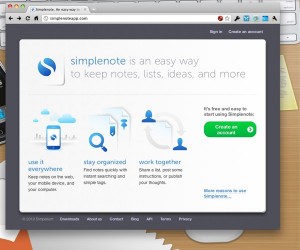
 You ever have the feeling that you need a backup brain? You know somewhere to just jot a note down wherever you are and then be able to get to it wherever you are? Believe me I have my share of fountain pens and moleskin notebooks for jotting things down, but I’m talking about electronic notes here.
You ever have the feeling that you need a backup brain? You know somewhere to just jot a note down wherever you are and then be able to get to it wherever you are? Believe me I have my share of fountain pens and moleskin notebooks for jotting things down, but I’m talking about electronic notes here.
There are lots of multi-platform electronic note taking tools out there, Evernote probably being the leader. But what about something just drop-dead simple? Just text. Just notes. Then we’re talking about SimpleNote.
So what is SimpleNote?
SimpleNote, just like the name implies, is a simple, basic note taking application/service. It’s just about text notes. No images. No voice notes. Not even much of an organization scheme (sorta, but I’ll get to that). Just text notes. And free.
SimpleNote is based in the cloud, so you can use it on the web or through a variety of apps. The key thing it is that you write a note one place, the note is synced to the main server so when you go to an app on an other OS, device, machine, whatever, your notes are all there.
First step, go to the SimpleNote website and sign up for the free account.
That basic, simple window is all you need to know about how SimpleNote works. There is a search box to find notes, the big plus sign creates notes, you can tag notes (and filter by tag), delete notes, check the version history, and “pin” notes (keeps it at the top of the list regardless of age—great for to-do lists). The tagging system and pinning are how you can organize your notes. Even if you don’t remember to tag your note, the search feature is lightening fast on all platforms.
While it’s nice that you can use a website to enter notes, that kinda defeats the “anywhere” idea. So, let’s talk about apps now.
For iOS, you can download the iOS version of SimpleNote from the App Store (free). The app is a universal app for iPhone/iPod Touch and iPad. It’s very much like the web interface; simple and it works. You sign in with your SimpleNote account and all your notes are synced up there. New notes, edits, etc they all carry across. One of the newer features in the iOS app is being able to share a note with another user through the iOS app. You can’t do this through the website, but I’d expect that feature to come soon. But once the note is shared, you can edit it wherever you wish.
On the Mac, we’ve used Notational Velocity or a new fork called Notational Velocity ALT, both of which sync with your main SimpleNote account. NV is an free, open-source app that has several forks already (like nvALT which adds previewing and more markdown support), but is true to the SimpleNote idea — simple and easy and light.
If you need a Windows version of a SimpleNote-compatible app or an app for another mobile device or even some other pretty cool SimpleNote tools, check out the downloads page. I can’t vouch for the Windows or non iOS apps there, but most are free to at least try. SimpleNote has an API as well, just in case you don’t see something you like and just want to build it yourself.
How much data and time is this going to take? That’s the great thing about SimpleNote, because the notes are purely text (even if you use markdown, textile or multimarkdown), there is very, very little data to transfer. On whatever platform or device that you might be using offline, syncing will happen with you connect. When the syncing happens, it’s almost instant. One moment you have just a couple notes, then, poof!, you have all the ones you’ve created since your last sync.
So…what else?
Nothing. Really, that’s it.
There isn’t a learning curve. You just start taking notes in SimpleNote. Because all the files and information are so small, syncing is almost instantaneous. You can copy information you find on one device, from another by creating notes. The service is free, but a premium version for a paltry $12/year gives you more backup versions of each note, unlimited third party app bandwidth, no ads, the ability to email in notes, and an RSS feed (which is great for shared notes!).
Worth it? Yeah, it’s on my to-do list to update to Premium.
This has been a basic post about just getting going. In the next post, I’ll talk about using SimpleNote to manage to-do lists, project notes, and other information. But there is even more you can do with SimpleNote. In the final post I’m going to talk about how I use SimpleNote to work on posts and book sections when I don’t want to haul my whole laptop around. As well as sharing notes for collaborative work.
Until then…get note taking!
Get the TNW newsletter
Get the most important tech news in your inbox each week.




